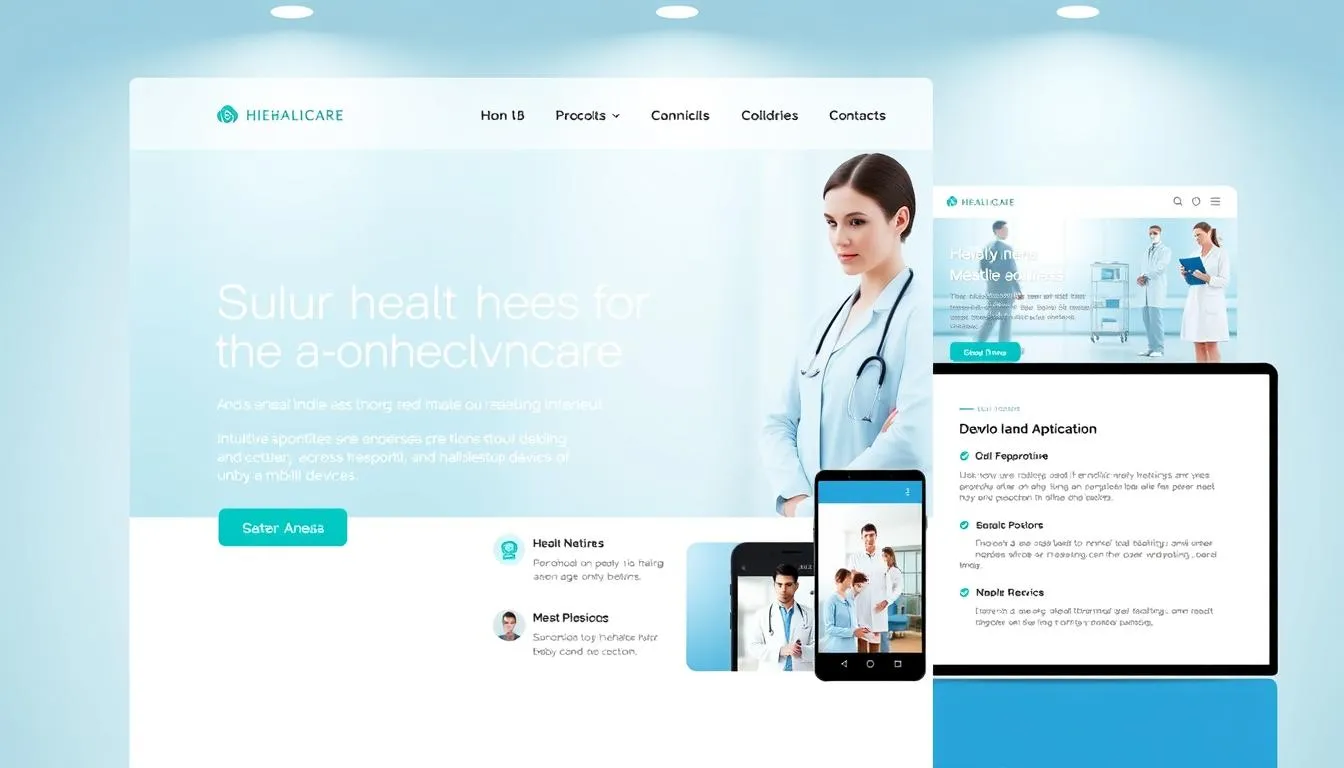Last Updated on: June 19, 2025
In today’s digital landscape, a robust online presence is vital for healthcare providers. A well-designed website is more than just a digital brochure; it’s a crucial tool for attracting and retaining patients.
A successful healthcare website must incorporate essential features that enhance patient engagement and provide a seamless user experience. Effective healthcare websites are not just about aesthetics; they are about functionality and accessibility.
By understanding the importance of healthcare website features, providers can create a digital platform that meets the needs of their patients and sets them apart from the competition.
Key Takeaways
- A well-designed website is crucial for healthcare providers.
- Patient engagement is a key factor in a successful healthcare website.
- Effective healthcare websites prioritize functionality and accessibility.
- A robust online presence is vital in today’s digital landscape.
- Understanding healthcare website features is essential for creating a competitive digital platform.
The Importance of Effective Healthcare Websites
The digital landscape has significantly impacted how patients interact with healthcare providers, making effective healthcare websites more important than ever. As the first point of contact for many patients, a healthcare website plays a crucial role in patient acquisition and retention.
Current Digital Expectations in Healthcare
Patients now expect to find comprehensive information about healthcare services, providers, and treatment options online. Meeting these digital expectations is vital for healthcare providers to remain competitive.
Impact on Patient Acquisition and Retention
A well-designed website not only attracts new patients but also helps retain existing ones by providing a user-friendly experience. This is crucial for building a loyal patient base.
First Impression and Trust Building
A professional and informative website creates a positive first impression, which is essential for trust building in the healthcare industry. Trust is a critical factor in patient decision-making.
User-Friendly Navigation and Structure
User-friendly navigation is the cornerstone of a successful healthcare website. It enables patients to find the information they need quickly and efficiently, improving their overall experience. A well-structured website not only enhances patient engagement but also contributes to the credibility of the healthcare provider.
Intuitive Menu Design
An intuitive menu design is crucial for guiding visitors through the website. It should be simple, logical, and easily accessible. By categorizing services and information in a clear manner, healthcare providers can ensure that patients can navigate the site with ease.
Advanced Search Functionality
Incorporating advanced search functionality allows patients to quickly locate specific information or services. This feature is particularly useful for patients who are looking for particular treatments or healthcare providers.
Clear Information Architecture
A clear information architecture is the backbone of a user-friendly website. It involves organizing content in a logical and accessible manner.
Service Categorization
Categorizing services into relevant groups helps patients find what they’re looking for. For instance, services can be grouped by department, such as cardiology, pediatrics, or oncology.
Location-Based Content Organization
For healthcare providers with multiple locations, organizing content by location can significantly enhance the user experience. This allows patients to find information specific to their local healthcare provider.
“A well-organized website is not just about aesthetics; it’s about creating a seamless experience for patients to access the care they need.”
Mobile Responsiveness and Accessibility
With the majority of internet users accessing healthcare information through mobile devices, a mobile-first design approach is no longer a luxury, but a necessity. This design philosophy prioritizes the smaller screens of mobile devices, ensuring that the website’s layout, content, and functionality are optimized for these devices first.
Mobile-First Design Approach
Adopting a mobile-first design means that the website’s architecture is built with the constraints and opportunities of mobile devices in mind. This approach not only enhances the user experience on mobile but also improves the site’s usability on larger screens.
ADA Compliance Requirements
Ensuring ADA compliance is critical for making healthcare websites accessible to everyone, including individuals with disabilities. Key aspects include:
- Screen reader compatibility
- Color contrast considerations
Screen Reader Compatibility
Screen readers rely on properly structured HTML to interpret and read out content to users. Ensuring that headings, links, and other elements are correctly labeled is essential.
Color Contrast Considerations
Adequate color contrast between the background and text is vital for readability. Guidelines recommend a contrast ratio of at least 4.5:1 for normal text.
Cross-Browser Compatibility
Healthcare websites must function seamlessly across different browsers and versions to cater to all users. Testing for cross-browser compatibility ensures that the site’s features and content are accessible regardless of the user’s browser choice.
Touch-Friendly Interface Elements
For mobile users, touch-friendly interface elements are crucial. Buttons, menus, and other interactive elements should be designed to respond accurately to touch inputs, enhancing the overall user experience.
Online Appointment Scheduling Systems
Implementing an online appointment scheduling system is a crucial step for healthcare providers to enhance patient satisfaction. This feature allows patients to book appointments at their convenience, reducing the administrative burden on staff and improving the overall patient experience.
Real-Time Availability Display
A key feature of online appointment scheduling systems is the real-time availability display. This shows patients the available time slots, enabling them to choose a time that suits them best. Real-time updates ensure that patients are not offered time slots that have already been booked or are no longer available.
Automated Confirmation and Reminders
Automated confirmation and reminders are another vital aspect of these systems. They help reduce no-show rates by sending patients reminders about their upcoming appointments. This not only improves patient engagement but also helps healthcare providers manage their schedules more efficiently.
Integration with Practice Management Software
Integration with practice management software is essential for a seamless scheduling process. This integration ensures that the scheduling system is updated in real-time, reflecting the latest changes in the healthcare provider’s schedule.
Multi-Provider Scheduling Options
Multi-provider scheduling options allow patients to book appointments with different healthcare providers within the same practice. This feature is particularly useful for larger healthcare organizations with multiple providers.
Emergency Appointment Requests
Emergency appointment requests enable patients to book urgent appointments. This feature is crucial for healthcare providers who need to accommodate patients with urgent needs.
Secure Patient Portals
Secure patient portals have become a cornerstone of modern healthcare, empowering patients to take control of their medical journey. These portals provide a safe and convenient way for patients to access their medical information, communicate with their healthcare providers, and manage their care.
Medical Records Access
One of the key features of secure patient portals is medical records access. Patients can view their medical history, including diagnoses, medications, and test results, giving them a comprehensive understanding of their health.
Secure Messaging Capabilities
Secure messaging capabilities enable patients to communicate with their healthcare providers, ask questions, and receive guidance without the need for phone calls or in-person visits.
Prescription Refill Requests
Patients can also use secure patient portals to request prescription refills, making it easier to manage their medications and reducing the administrative burden on healthcare providers.
Bill Payment Options
Bill payment options are another convenient feature of secure patient portals, allowing patients to pay their medical bills online and reducing the risk of late or missed payments.
Test Results Delivery
Secure patient portals also enable the delivery of test results, ensuring that patients receive their results in a timely and secure manner.
Appointment History
Finally, secure patient portals often include appointment history, allowing patients to view their past appointments and schedule future ones as needed.
By providing these features, secure patient portals enhance patient engagement and improve the overall healthcare experience.
What Features Should Healthcare Websites Have for HIPAA Compliance?
HIPAA compliance is a top priority for healthcare websites, requiring robust security measures to protect patient data. Ensuring the confidentiality, integrity, and availability of protected health information (PHI) is paramount.
Data Encryption Requirements
One of the critical features for HIPAA compliance is data encryption. Encrypting data both in transit and at rest ensures that even if unauthorized access occurs, the data will be unreadable without the decryption key. This is a fundamental measure in safeguarding PHI.
Secure Forms and Data Collection
Healthcare websites must implement secure forms for data collection. These forms should be designed with security in mind, using HTTPS, and ensuring that data entered by patients is encrypted and stored securely.
Privacy Policy and Consent Management
A clear privacy policy is essential, outlining how patient data is collected, used, and protected. Effective consent management involves informing patients about their rights and obtaining their consent for data processing.
Access Controls and Authentication
Access controls and authentication mechanisms are vital to prevent unauthorized access to PHI. This includes implementing role-based access controls and ensuring that users authenticate securely.
Audit Trails and Logging
Maintaining audit trails and logs of all interactions with PHI is required for HIPAA compliance. This helps in tracking any access or changes to patient data, aiding in the detection of potential breaches.
By incorporating these features, healthcare websites can ensure HIPAA compliance, protecting patient data and maintaining trust.
Telemedicine Integration
Healthcare providers are now turning to telemedicine integration to enhance patient care and accessibility. This integration involves several key features that work together to provide a seamless experience for patients.
Video Consultation Platforms
At the heart of telemedicine integration are video consultation platforms. These platforms enable healthcare providers to conduct virtual consultations, ensuring that patients receive timely medical attention from the comfort of their homes.
Virtual Waiting Rooms
Virtual waiting rooms are another crucial aspect, allowing patients to wait comfortably before their consultation, much like they would in a physical waiting room.
Technical Requirements for Patients
To ensure a smooth experience, healthcare websites must clearly outline the technical requirements for patients. This includes compatible devices, internet speed, and software requirements.
Electronic Prescribing Through Telehealth
Electronic prescribing through telehealth streamlines the medication process, enabling healthcare providers to prescribe medications directly to pharmacies during virtual consultations.
Follow-up Appointment Scheduling
Finally, follow-up appointment scheduling allows patients to easily schedule their next appointments after a telehealth consultation, ensuring continuity of care.
By incorporating these features, healthcare providers can significantly enhance the telemedicine experience, making healthcare more accessible and convenient for patients.
Content Strategy for Healthcare Websites
Creating a content strategy tailored to healthcare needs is key to enhancing patient engagement and trust. A well-planned content strategy helps healthcare providers communicate effectively with their audience, addressing their needs and concerns.
Educational Resources and Blog
Providing educational resources and maintaining a blog can significantly enhance a healthcare website’s value to its visitors. By publishing informative articles, healthcare providers can establish themselves as authorities in their field, fostering trust among potential patients.
Provider Profiles and Credentials
Provider profiles are essential for patient confidence. By showcasing the qualifications, specialties, and experience of healthcare professionals, patients can make informed decisions about their care.
Service Descriptions and Specialties
Clearly outlining service descriptions and specialties helps patients understand the range of services offered by a healthcare provider. This transparency can improve patient satisfaction and reduce confusion.
Multilingual Content Options
Offering multilingual content can significantly expand a healthcare provider’s reach. By catering to diverse linguistic populations, healthcare websites can become more inclusive and accessible.
Condition-Specific Information
Providing condition-specific information is crucial for patient education. Detailed information about various health conditions and their treatments can empower patients to take an active role in their healthcare.
Patient Testimonials and Social Proof
Building trust with potential patients is crucial for healthcare providers, and one effective way to achieve this is through patient testimonials. By showcasing real experiences from existing patients, healthcare organizations can demonstrate their commitment to quality care.
There are several ways to collect and present patient testimonials:
- HIPAA-Compliant Review Collection: Ensuring that patient reviews are collected in compliance with HIPAA regulations is essential for maintaining patient privacy.
- Success Stories and Case Studies: Detailed accounts of successful treatments or patient journeys can provide valuable insights into the quality of care provided.
- Provider Ratings Integration: Allowing patients to rate their healthcare providers can help others make informed decisions about their care.
- Video Testimonials: Using video to share patient testimonials can add a personal touch and make the experiences more relatable.
By incorporating these elements, healthcare providers can effectively utilize social proof to build trust and credibility with potential patients.
SEO Optimization for Healthcare Practices
In today’s digital landscape, a well-optimized website is crucial for healthcare practices to attract and retain patients. With the majority of patients turning to search engines to find healthcare services, a robust SEO optimization strategy can significantly improve a healthcare website’s search engine rankings.
Local SEO Strategies
Local SEO is vital for healthcare providers to reach patients in their area. By optimizing their website for local search, healthcare practices can increase their online visibility, driving more traffic to their website and physical location.
Medical Keyword Research
Medical keyword research is essential to identify relevant terms and phrases that patients use when searching for healthcare services. By incorporating these keywords into their website content, healthcare providers can improve their search engine rankings.
Google Business Profile Optimization
Google Business Profile optimization is critical for local search visibility. By claiming and optimizing their Google Business Profile, healthcare providers can ensure that their practice appears in local search results, maps, and other Google services.
Structured Data for Medical Organizations
Using structured data can enhance search engine understanding of a healthcare website’s content. By adding schema markup to their website, healthcare providers can provide search engines with additional context about their practice, services, and credentials.
Content Optimization for Healthcare Queries
Content optimization for healthcare queries ensures that a healthcare website appears in search results for relevant health-related questions. By creating high-quality, informative content that addresses patient concerns, healthcare providers can establish their authority and expertise in their field.
Performance and Loading Speed
The performance and loading speed of a healthcare website play a significant role in patient engagement. A slow-loading website can lead to high bounce rates and negatively impact user experience.
Optimizing Images for Faster Load Times
One crucial aspect of improving website performance is image optimization. By compressing images and using appropriate file formats, healthcare websites can significantly reduce page load times.
Effective Caching Strategies
Implementing caching strategies is another effective way to enhance website performance. By storing frequently-used resources locally, caching reduces the need for repeat downloads, resulting in faster page loads.
Other key factors that influence website performance include:
- Server response time
- Content delivery networks (CDNs)
- Core Web Vitals optimization
By focusing on these areas, healthcare websites can improve their loading speed, providing a better user experience and potentially improving search engine rankings.
Conclusion: Building a Patient-Centered Healthcare Website
A well-designed healthcare website is crucial for patient engagement and care. By incorporating key features such as user-friendly navigation, mobile responsiveness, and secure patient portals, healthcare providers can create a patient-centered healthcare website that truly supports their patients’ needs.
Effective website design plays a vital role in enhancing the patient experience, from online appointment scheduling to telemedicine integration. By focusing on SEO optimization, performance, and content strategy, healthcare providers can ensure their website is easily accessible and provides a positive experience for patients.
A patient-centered healthcare website is essential for building trust and fostering patient engagement. As the healthcare landscape continues to evolve, a well-designed website will remain a cornerstone of quality patient care. By prioritizing patient needs and incorporating the latest digital advancements, healthcare providers can create a website that makes a meaningful difference in the lives of their patients.
FAQ
What are the essential features of a successful healthcare website?
A successful healthcare website should have user-friendly navigation, mobile responsiveness, online appointment scheduling systems, secure patient portals, and telemedicine integration, among other features.
Why is mobile responsiveness important for healthcare websites?
With the majority of internet users accessing websites through mobile devices, a mobile-responsive design ensures that the website is optimized for smaller screens, improving the user experience across all devices.
How can healthcare websites ensure HIPAA compliance?
Healthcare websites can ensure HIPAA compliance by implementing robust security measures, including data encryption, secure forms and data collection, access controls, and audit trails.
What is the role of patient portals in healthcare websites?
Secure patient portals provide patients with secure access to their medical records, allowing them to take a more active role in their care, and offer features like secure messaging, prescription refill requests, and bill payment options.
How can telemedicine integration benefit healthcare providers?
Telemedicine integration can enhance patient access to care, expand the reach of healthcare providers, and improve patient outcomes by providing a seamless experience for virtual consultations.
What is the importance of SEO optimization for healthcare websites?
SEO optimization is crucial for ensuring that a healthcare website is visible to potential patients, and involves strategies like local SEO, medical keyword research, and content optimization for healthcare queries.
How can healthcare websites improve their performance and loading speed?
Healthcare websites can improve their performance and loading speed by optimizing images, using caching strategies, reducing server response time, and leveraging content delivery networks.
What is the significance of patient testimonials and social proof on healthcare websites?
Patient testimonials and social proof are powerful tools for building trust with potential patients, and can be collected in a HIPAA-compliant manner to provide valuable feedback and insights.




